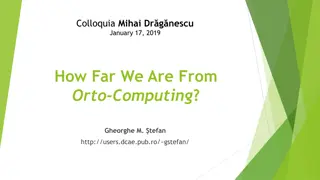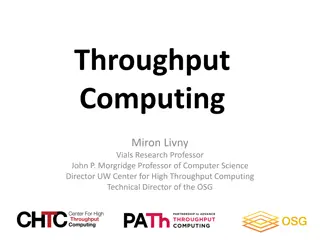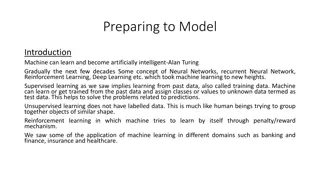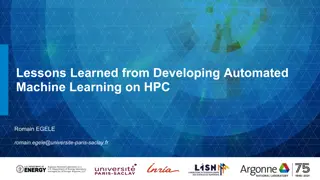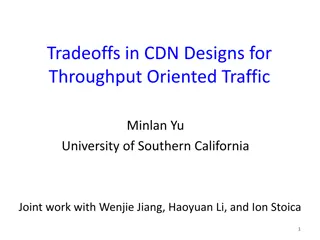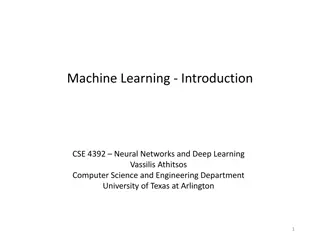Exploring Throughput Machine Learning in High-Throughput Computing
Explore the applications of Artificial Intelligence and Machine Learning in the context of High-Throughput Computing (CHTC). Learn about AI/ML methodologies, deep learning, data engineering, and their roles in enabling novel scientific advancements. Discover use cases, ongoing work, and future plans in this dynamic field.
Download Presentation

Please find below an Image/Link to download the presentation.
The content on the website is provided AS IS for your information and personal use only. It may not be sold, licensed, or shared on other websites without obtaining consent from the author. Download presentation by click this link. If you encounter any issues during the download, it is possible that the publisher has removed the file from their server.
E N D
Presentation Transcript
Throughput Machine Learning in CHTC Ian Ross Data Engineer, Center for High Throughput Computing
Outline Artificial Intelligence and Machine Learning a too-brief overview Throughput Machine Learning Example use cases ML workflows and usage in CHTC Ongoing work Future plans 7/11/24 2
AI/ML a too-brief overview Artificial intelligence Methods and software to enable machines to observe, identify, and react to stimuli to achieve a defined goal Machine learning Algorithms and practices to enable machines to recognize patterns in data and generalize to new data to achieve tasks without instruction Subset of AI 7/11/24 3
Artificial Intelligence Machine Learning Deep learning Using artificial neural networks to capture connections and strengths (weights) between inputs and outputs Generative AI Models trained to generate data similar to that used to train Large language models 7/11/24 4
Artificial Intelligence Machine Learning Data science Data engineering Deep learning Using artificial neural networks to capture connections and strengths (weights) between inputs and outputs Generative AI Models trained to generate data similar to that used to train Large language models 7/11/24 5
Artificial Intelligence Statistics Machine Learning Data science Data engineering Deep learning Using artificial neural networks to capture connections and strengths (weights) between inputs and outputs Generative AI Models trained to generate data similar to that used to train Bioinformatics Large language models 7/11/24 6
Artificial Intelligence We care about these things primarily as tools and techniques that enable new and novel SCIENCE Statistics Machine Learning Data science Data engineering Deep learning Using artificial neural networks to capture connections and strengths (weights) between inputs and outputs but there are complications Generative AI Models trained to generate data similar to that used to train Bioinformatics Large language models 7/11/24 7
AI and ML inherent challenges Data and computing needs can be immense GPUs bring their own layer of complexity Dropouts, user education, administration, cost, availability Ecosystem moves fast and everybody wants to be first Copy-paste recipes propagate faster than truly educational ones Software stacks with similar, but not quite the same, interface (recipe challenges more to come) Training can be a long process Checkpointing required 7/11/24 8
AI and ML inherent challenges These are not new challenges! User education, scheduling, data movement, workflow orchestration There is nothing new under the sun 7/11/24 9
7/11/24 10
Throughput machine learning in CHTC Throughput machine learning applies our tried and tested technologies to ML applications Data movement but at a much bigger scale (and potentially across nodes) Checkpointing but at an epoch boundary (and potentially across nodes) DAGMan but with a few extra bells and whistles (and potentially across nodes) Resources (GPUs) are a bit more valuable and policy is king Prioritization, scheduling, pre-emption Three use cases to highlight familiarity and new twists.. 7/11/24 11
Throughput machine learning Use case 1 I have 18 million scientific articles, and I want to search for, extract, and synthesize information across them! This is a high-throughput inference problem! 7/11/24 12
I have 18 million scientific articles, and I want to search for, extract, and synthesize information across them! This is a high-throughput inference problem! I can help with the LLM+RAG side of things! Jason Lo, DSI collaborator 7/11/24 13
Throughput inference Using existing models for inference in traditional high- throughput approaches (with or without GPUs) Examples: Embedding Vector or scalar representations of input data Predictions LLM security studies 7/11/24 14
7/11/24 15
Throughput machine learning Use case 2 I want to train many models, empirically measure their predictive power, and use those models to drive scientific exploration. 7/11/24 16
Throughput Training Training (potentially many) relatively small models to drive additional inference or science work Examples: Hyperparameter optimization Ensemble learning Fine-tuning Ablation studies From https://docs.ultralytics.com/guides/hyperparameter-tuning/ LoRA: Low-Rank Adaptation of Large Language Models (https://arxiv.org/pdf/2106.09685) 7/11/24 17
Throughput machine learning Use case 3 I want to create a foundation model for bioimaging and want to scale training across multiple nodes! 7/11/24 18
Multi-node training in CHTC Aka what can we do with existing tools? Challenges: Heterogeneous resources (solved with requirements) Asynchronous resource acquisition (pytorch elastic) Nodes involved need a rendezvous server address (solved with DAG) Performance TBD but won t compare to the big dogs in the LLM fight. 7/11/24 19
Multi-node training in CHTC (POC) train.dag gpuworker_sub.template PROVISIONER RANK0 gpu.sub JOB WORKER gpuworker.sub executable = train.sh SCRIPT PRE WORKER injectRank0Name.sh gpu.sub arguments = SERVER_IP_ADDRESS_GOES_HERE SERVER_PORT_GOES_HERE requirements = (GPUS_MaxSupportedVersion > 12000) && (GPUs_GlobalMemoryMb >= 32000) && machine != "SERVER_IP_ADDRESS_GOES_HERE executable = train.sh arguments = rank0 9640 transfer_input_files = train.py, train.sh, /usr/lib64/python3.9/site- packages/htcondor/htchirp/htchirp.py injectRank0Name.sh train.sh #!/bin/sh if [ "$1" = "rank0" ] then # rank0 port h=$(hostname) p=$2 echo "$h $p" > contact_file python3 htchirp.py put contact_file rank0_contact rm contact_file else h=$1 p=$2 fi torchrun --nnodes 1:2 --nproc_per_node 1 --rdzv_backend c10d --rdzv-id 1 --rdzv-endpoint "$h:$p" # A prescript for the workers to inject # the address and port of the rdzv server # into their submit file. # We assume this is in a file in the # cwd named "rank0_contact" read name port < rank0_contact sed -e "s/SERVER_IP_ADDRESS_GOES_HERE/${name}/g" \ -e "s/SERVER_PORT_GOES_HERE/${port}/g" < gpuworker.sub.template \ > gpuworker.sub 7/11/24 20
Multi-node training in CHTC (POC) 1. Provisioner (rank0) node starts Execute Point Access Point 7/11/24 21
Multi-node training in CHTC (POC) 1. Provisioner (rank0) node starts 2. Provisioner node chirps back address and port Execute Point Access Point 7/11/24 22
Multi-node training in CHTC (POC) 1. Provisioner (rank0) node starts 2. Provisioner node chirps back address and port 2a. rank0 torchrun starts ( Execute Point Access Point ) 7/11/24 23
Multi-node training in CHTC (POC) 1. Provisioner (rank0) node starts 2. Provisioner node chirps back address and port 2a. rank0 torchrun starts ( 3. Pre-script for worker node runs, injecting rank0 job address into worker submit template Execute Point Access Point ) 7/11/24 24
Multi-node training in CHTC (POC) 1. Provisioner (rank0) node starts 2. Provisioner node chirps back address and port 2a. rank0 torchrun starts ( 3. Pre-script for worker node runs, injecting rank0 job address into worker submit template 4. Worker node runs and torchrun starts ( rendezvous server Execute Point Access Point ) )with rank0 node defined as 7/11/24 25
ML workflows and usage in CHTC A (very) unscientific survey Training vs inference: 60/40 split training to inference Software stack: Pytorch (~60%), parabricks, Lightning Domains: Bioinformatics, LLMs, empirical ML (bias detection), Notable feedback: For what it s worth, more physical gpus of moderate size (16GB memory) is much more preferable for my purposes than an H100 with 80GB memory. We are super thankful for the the CHTC providing GPU support, as this research would not have been possible without it! 7/11/24 26
Ongoing work Pelican/pytorch integration Tutorials, documentation, recipes https://github.com/CHTC/templates -GPUs https://chtc.cs.wisc.edu/uw- research-computing/machine- learning-htc Additional DAG workflows Evaluation + early abort More surveys and resource understanding 7/11/24 27
Future plans Answers to: How does the heterogeneity of resources and availability impact a checkpointed + restarted training process? How do we effectively move datasets for training (and inference!)? What, if any, gaps exist in enabling users to handle large ensemble trainings? and where-ever AI developments and this community take us. 7/11/24 28











